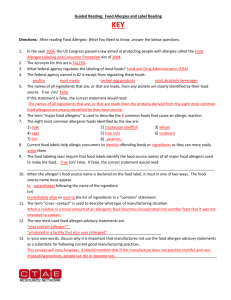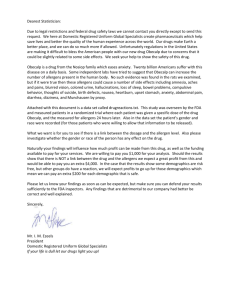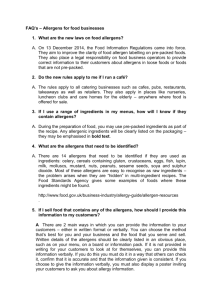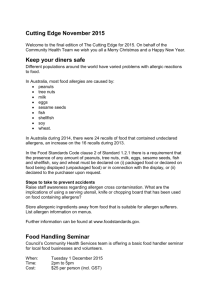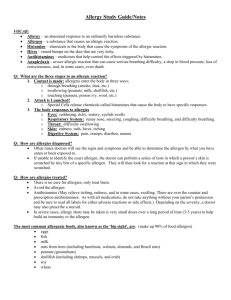ALLERGENS CONTROL- company plan
advertisement
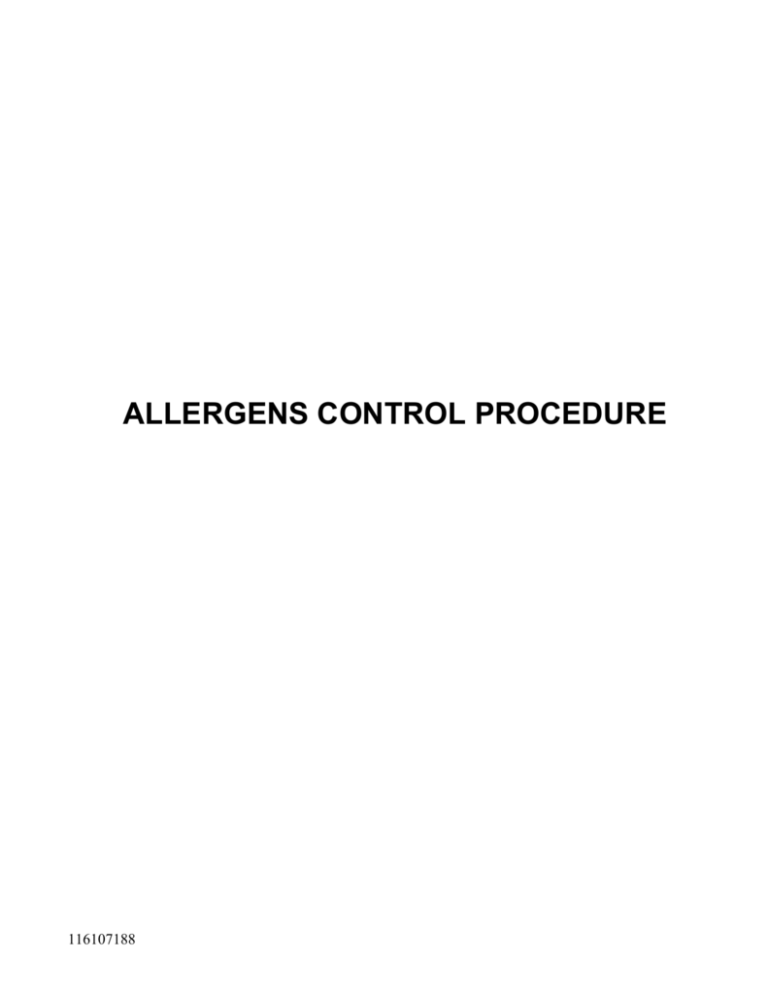
ALLERGENS CONTROL PROCEDURE 116107188 INTRODUCTION: Health Canada and the Canadian Food Inspection Agency (CFIA) have jointly identified 10 food products that are primarily responsible for about 90 percent of severe adverse food reactions among the Canadian population. These products are peanuts, tree nuts, wheat, soy, milk, eggs, fish, crustacean and shellfish, sesame seeds, and sulphites. Symptoms of a food allergy can appear immediately after the food is consumed or can be delayed. Immediate reactions can range in severity from a skin rash or a slight itching of the mouth, to migraine headaches and to anaphylactic shock and death. Some test results have indicated that it can take as little as 1-2 mg (or in some cases less) of the offending food to cause allergic reactions in sensitive individuals. There is currently no cure for a food allergy, other than to avoid eating the offending food. Allergen proteins are naturally occurring and cannot be eliminated by cooking or baking. The purpose of this procedure is to describe the control methods used by Our company. to ensure that none of its products contain undeclared allergens that could provoke an allergic or a sensitivity reaction in persons that are susceptible to these kinds of reactions. ALLERGEN LIST Here is the list of allergens currently present in Our company. with corresponding colour codes: 1. Milk 2. Eggs 3. Peanuts 4. Tree nuts 5. Fish 6. Shellfish 7. Soy 8. Wheat 9. Sesame 11. Sulfite YELLOW Not present in our plant Not present in our plant PINK Not present in our plant Not present in our plant GREEN Not present in our plant WHITE SCOPE OF APPLICATION This procedure applies to all products manufactured by Our company Ltd. RESPONSIBILITIES 116107188 The HACCP Coordinator makes sure that the procedure is followed and updated, if necessary. The Plant Supervisor and or designate makes sure that the employees perform their work in accordance with the procedure. Special caution is exercised when changing supplier and bringing new ingredient or packaging material. The HACCP Coordinator ensures suppliers have a documented and implemented allergens control plan at their establishment. HACCP Coordinator makes sure that the labels in the system are updated to indicate the products contain allergen. The HACCP Coordinator verifies that sanitation of the equipment is performed according to written SSOP’s. PROCEDURE RECEIVING/ STORAGE Suppliers of ingredients and packaging materials for Our company Ltd. are required to supply an allergen checklist (allergen content of the raw material). Based on these checklists all ingredients are grouped in the following groups: Egg, Fish, Milk, Milk and Soy, Sesame, Soy, Soy and Sulfite, Soy and Wheat, Sulfite, Wheat, Wheat and Sulfite Wheat, Soy and Sulfite When receiving clerk receives ingredient, allergen hazard status is confirmed by checking “Allergen hazard list” in the binder with receiving / shipping forms. If in doubt, must contact HACCP Coordinator and or designated personnel immediately. Colour coded labels are printed, receiving date stamped on the labels that are applied on received products. If ingredient contains more than one allergen, colour coded label for each allergen will be applied (i.e. for ingredient containing milk and fish allergens receiver must apply 2 colour coded labels on product). If full skid of the same ingredient is received, receiver must apply labels on the bottom row of the skid. The ingredients containing allergens are stored in specific zones properly identified with signs location. These zones are located in the warehouse, coolers and freezer. Allergen containing products are stored on lower shelves to avoid the possibility of outflow on other products. Exceptionally, some ingredients may be stored outside of the allergenic product zones (mainly because of a shortage of available space) but only if the containers have never been opened and are below ingredients, which do not contain allergens or contain other type of allergens. 116107188 PICK-UP OF THE REQUIREMENTS FOR PRODUCTION Requirements for production are picked-up by designated production personnel. Allergens hazard ingredients are placed on separate skids or on the bottom of the skid separated with clean skid cover from non-allergens. Individual units containing allergen(s) are taken from full skid and colour coded labels with receiving date are applied to each individual unit send to production area. If complete skid is send then there will be no need to apply any additional labels. PRODUCTION/PROCESSING Products containing known allergens hazard are scheduled for production at the end of the production run. This scheduling is documented on production schedule and any changes are documented on Daily Production Form. Once a production line has been used to produce an allergen hazard containing products, the processing equipment is fully washed before another non-allergen product is produced on the same equipment. All scoops and scales used are to be washed as well. The production personnel must wash hands, change gloves and clean or change uniform after handling allergen hazard-containing products. Most of the finished products are closed immediately after filling process. If not, they are covered to protect them from cross contamination. All spills are cleaned immediately. The scheduling and cleaning is documented and verified by the HACCP Coordinator. LABELLING AND PACKAGING MATERIALS The HACCP Coordinator checks labels on incoming ingredients; supplier may have sent the wrong product or used the wrong label. Verifies label accuracy; updates to reflect current formula, and ensures compliance to labelling regulations which generally requires declaration of all ingredients; exception to this include spices, flavours (vinegar) and processing aids and incidental additives at insignificant levels or that have no technical function or effect. If an incidental additive or processing aid is derived from an allergenic ingredient, it must be included on the label. He/she considers cross-contact potential on packaging equipment and verifies product traceability; use a lot numbering system on raw materials to finished products to ensure recovery of all products in an event of a recall, conduct a mock recall to verify it. SANITATION Our company has standardized procedures for sanitation operations (SSOP’s). The Production Manager, Production Supervisor, Warehouse Supervisor and HACCP Coordinator ensures that proper procedures followed by the sanitation crew. The procedure for washing equipment after allergen hazard containing products includes: full wash down starting with presoaking, foaming, rinsing and finishing with sanitizing equipment. 116107188 HACCP Coordinator and or designate personnel perform a washing efficiency test by visual inspection and checking the concentration of the sanitizer using QT 10 strips. If the result is satisfying, equipment gets approval to be used in production. If the result of the inspection is not satisfying, the appropriate corrective action is taken immediately to correct the deficiency. FINISH PRODUCT STORAGE Finish products containers are usually opened outside of Our company Ltd. by the customer. In the event that is necessary to open some finished products containers, they are open only during the time necessary to perform the operation that has to be done and they are immediately closed. When product is in finished package we deemed product to be safe and not separate them on “per allergen” basis. TRAINING AND EDUCATION At Our company we ensure all employees have an understanding of the allergen hazard control procedures so they believe in its importance as a part of the facility’s food safety program. Points include: define all allergens hazard consequences to sensitive people, importance of allergen hazard control, most common areas where problems occur, and control measures. 116107188

